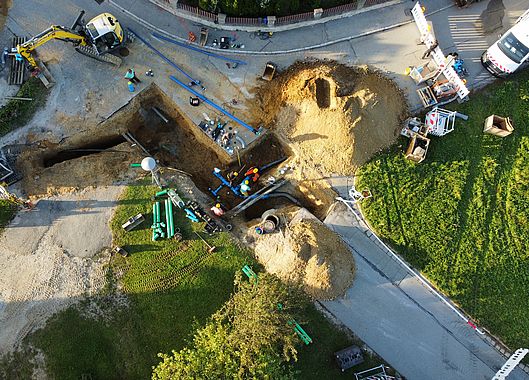"Hawle-CAD" supports successful BAIO® refurbishment construction site
In the market town of Winzer in the district of Deggendorf, the local grid line was due for renovation. A total of three important junctions were to be replaced within a very short space of time. Interest in the BAIO® system was aroused during a product-specific training course in accordance with DVGW Code of Practice GW 326 (A) on the mechanical joining of PE pipes in gas and water distribution.
For this renovation project, it made sense to use the BAIO® system with new PE pipes for the valve crosses and to flexibly connect them to the existing pipes, consisting of DN 80 to DN 200 cast iron and PVC pipes. The preparatory work was carried out by the municipality using the Hawle CAD planning tool. Each node was plotted and the exact list of materials was worked out. With the material ordered according to plan, the renovation could begin. The work on the large valve cross and on a small valve cross had to be carried out in one night, as there could be no interruption to the water supply during the day. The work started in the evening and finished on time in the early morning. The renovation began at the large gate valve cross with the unscrewing of the water pipe, the capping of the pipes, the removal of the concrete bearings and the preparation of the construction pit.
The connection to the old cast iron and PVC pipes was made using the installation socket pieces (EMS pieces) with multi-zone sockets, which were pushed onto the old pipes. The new valve crosses were partially assembled outside the excavation pit and then lifted into the excavation pit, where they were connected together. The PE pipes were connected using PE weld-in ends including a clamping ring. This was followed by the locking of the EMS pieces with the sliding cross, making optimum use of the displacement range. Finally, the EMS pieces were connected to the old pipes with a longitudinal force fit. It is particularly important in the renovation sector that BAIO® connections can be angled on all sides, as the old pipework is often not optimally aligned. After fixing the joint, a tele-hydrant with BAIO® spigot end and anti-dirt and anti-twist protection was installed and the tele-fittings were fitted to the gate valves.
The small number of components and connections and the angled push-fit socket connection of up to 3° per spigot-end socket connection impressed the employees on site. They were very satisfied: "The handling was very easy and the time saved in terms of installation was very significant. The changeover to the BAIO® system is a done deal for us."

